Marvin Stone patented the sipping straw – here’s the story of his new way of drinking for the world
Ohio native and Civil War veteran Marvin C. Stone was, according to lore, sipping a mint julep through hollow rye grass – straw – when he was inspired to disrupt millennia of drinking history.
Humans for millennia siphoned the liquid pleasures of life between their lips through a hollow piece of grass — through straw.
It took a 19th-century American entrepreneur, a Civil War veteran from Ohio, to conceive of a better, more consistent way to sip and savor a refreshment.
Marvin Stone is the father of the drinking straw.
Stone founded a manufacturing company in Washington, D.C., after the war to produce paper cigarette holders.
The businessman conceived a new way of drinking at the world.
His moment of inspiration came, according to oft-told lore, while sipping a mint julep through a hollow piece of rye grass.

Marvin C. Stone patented the drinking straw in 1888. He was born in Ohio in 1842 and was wounded in combat during the Civil War. He manufactured the original paper drinking straws at his factory in Washington, D.C. (Itinerary of Seventh Ohio Volunteer Infantry/Public Domain)
"Drinking-type straws are abundant in nature," The Old Farmer’s Almanac wrote about the natural and agricultural origins of what's now a mass-produced consumer product.
Rye stalks, the Almanac notes, were fairly common — and free. But they often disintegrated and left residue in the drink.
"Drinking-type straws are abundant in nature." — The Old Farmer's Almanac
Manufactured straws date back to the earliest civilizations. They were a luxury item, however, not one accessible to the masses.
"Ancient Sumerians … submerged long, thin tubes made from precious metals into large jars to reach the liquid sitting below fermentation byproducts," National Geographic U.K. reported in a 2018 history of the now-humble straw.

Painted relief depicting a Syrian warrior drinking through a tube from a two-handled jar, Ancient Egypt, Ancient Egyptian New Kingdom, 18th Dynasty, 1350 BC. (Werner Forman/Universal Images Group/Getty Images)
NatGeo's profile came as the modern plastic straw found itself the center of a global controversy that meshed the combustible topics of politics and environment.
Paper straws, much like those patented more than a century earlier, were suddenly touted as the savior of the planet.
HEART DISEASE DEATH LINKED TO OBESITY HAVE TRIPLED IN 20 YEARS, STUDY FOUND: ‘INCREASING BURDEN’
But a new movement in the heated straw debate has emerged in recent years. It offers age-old rye grass straws as a more environmentally friendly option than plastic or paper.
Stone's 19th-century paper straws, once too antiquated, may soon be deemed too modern.
Innovation in his genes
Marvin Chester Stone was born in Portage County, Ohio, on April 4, 1842, to Chester and Rachel Stone.
He proved a curious boy with mechanical aptitude, a tinkerer’s mind and innovation in his genes. Dad Chester is credited with creating an improved washing machine and a better cheese press, according to several reports.
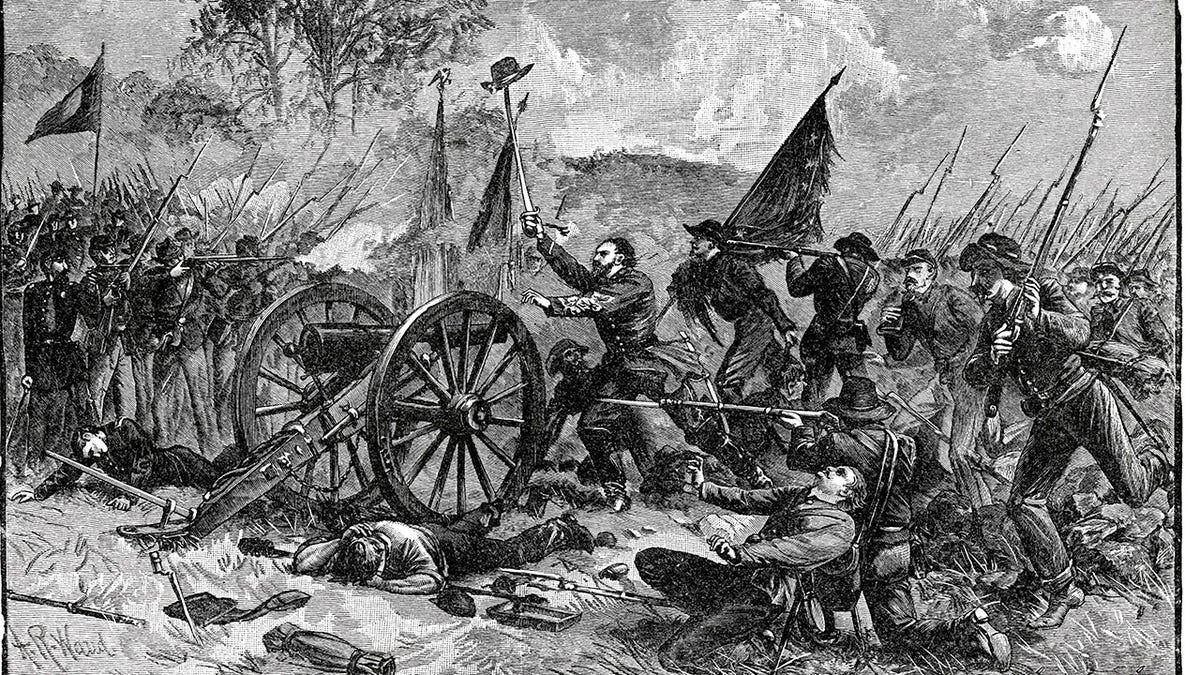
The Battle of Gettysburg, American Civil War, 1863. Marvin Stone, who patented the paper straw in 1888, fought at Gettysburg and at Chancellorsville — and was "wounded and disabled from active duty" later. (Universal History Archive/Universal Images Group via Getty Images)
"Marvin C. Stone inherited his father’s genius and invented many useful articles in his boyhood," read a tribute after his death in a period publication called The Home Furnishing Review.
Stone was studying at Oberlin College in Ohio when the nation erupted in Civil War. He joined the 7th Ohio Volunteer Infantry as a private.
"Marvin C. Stone inherited his father’s genius and invented many useful articles in his boyhood." - The Home Furnishing Review
"He fought at Gettysburg and Chancellorsville, and was wounded and disabled from active duty in the Battle of Lookout Mountain, near Chattanooga, Tennessee on Nov. 24, 1863," author Mary Bellis wrote for education site ThoughtCo.com.

A racegoer holds a mint julep cocktail before the 145th running of the Kentucky Derby at Churchill Downs in Louisville, Kentucky, on Saturday, May 4, 2019. At the 145th running of the Kentucky Derby that year, a field of 19 horses would enter the starting gates, each one gunning to finish at the winner's circle with bouquet of roses and a $1.86 million purse. (Luke Sharrett/Bloomberg via Getty Images)
Stone was sent to Washington, D.C., to recover from his battle wounds. He spent the rest of his life in the nation’s capital, soon the center of the American drinking-straw industry.
He invented a machine to produce paper cigarette holders, and opened a series of Washington, D.C., factories to manufacture the product.
"Legend has it that Marvin Stone invented the first paper drinking straw while sipping a mint julep after work." — Smithsonian Institution’s Lemelson Center
His moment of global habit-changing innovation came as his paper business prospered.
"Legend has it that Marvin Stone invented the first paper drinking straw while sipping a mint julep after work," the Smithsonian Institution’s Lemelson Center for the Study of Invention and Innovation reports in its history of the straw.
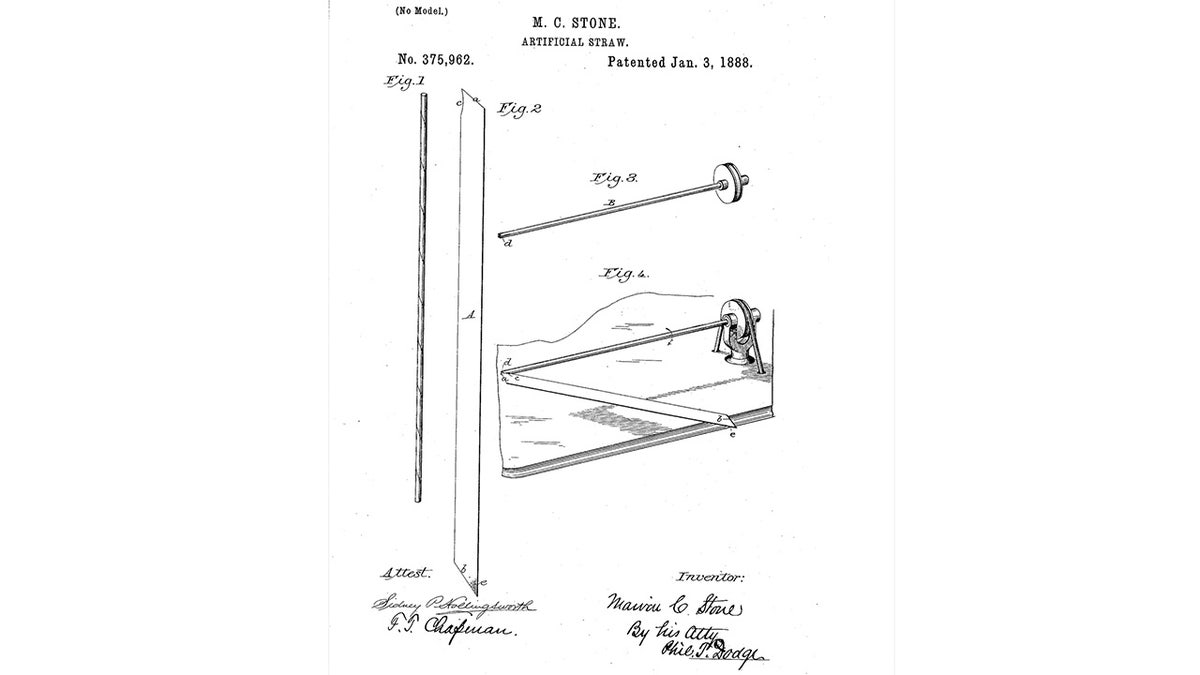
Marvin C. Stone, a Civil War veteran, patented the drinking straw in 1888. He manufactured them at his factory in Washington, D.C. (U.S. Patent and Trademark Office/public domain)
"Dissatisfied with the way (grass) straws would break down and leave a gritty residue in the drink, Stone fashioned his first straw by winding strips of paper around a pencil, removing the pencil, and gluing the strips together."
He began testing his innovation at "a local drinking establishment," Smithsonian reported, where it was "enthusiastically received."
He fashioned a sturdier commercial version from manila paper coated in paraffin to reduce the rate at which they turned soggy. He received the patent for his "artificial straw" on Jan. 3, 1888.

An 1895 advertisement for paper drinking straws, patented by Marvin C. Stone in 1888 and produced at his factory in Washington, D.C. (American Druggist and Pharmaceutical Record/public domain)
He was mass-producing paper straws by 1890. Stone soon became the signature name in the straw game.
"Every straw is sweet clean and perfect," said an 1895 advertisement for "Stone’s Patent Paper Julep Straws."
Paper or plastic
The paper straw business pioneered by Stone appeared to die in the 1960s.
Plastic straws appeared suddenly from several different producers, following advances in plastics technology.
Plastic straws were cheaper and easier to produce than paper straws. And, most importantly and much to the delight of consumers, they didn’t disintegrate, get soggy or lose their essential sipping power.

Plastic straws wrapped in paper and plastic forks are seen at a food hall in Washington, D.C., on June 20, 2019. The decision to ban plastic straws in the city that's the home of Marvin Stone's patented original paper drinking straw drew international attention. (ERIC BARADAT/AFP via Getty Images)
A sipping straw without sipping power, it turns out, is a flawed straw.
The dependable plastic straw proved popular and became ubiquitous around the world in just a few decades. Generations came of age knowing only a world of high sipping-power plastic straws.
The synthetic straws were not perfect, however. Just decades after their arrival, plastic straws were loudly cited as the source of global catastrophe.
"In just the U.S. alone, one estimate suggests 500 million straws are used every single day." — National Geographic
"In just the U.S. alone, one estimate suggests 500 million straws are used every single day … As many as 8.3 billion plastic straws pollute the world's beaches," National Geographic reported in its 2018 straw treatise.
Many restaurants, consumers and private businesses began to reduce their use of plastic straws. Cities, states and even entire countries worldwide have since enacted plastic straw restrictions.

Individual stalks are bundled in a sheaf when harvesting rye straw for the production of drinking straws in a field near Lübec, Schleswig-Holstein, Germany in 2020. Special rye is harvested and offered across the European Union as a more environmentally friendly alternative than plastic or paper straws. (Jens Büttner/picture alliance via Getty Images)
Stone’s paper straw, all but forgotten, enjoyed a sudden and unexpected rebirth in the 21st century courtesy of an asymmetric culture war that invaded even the simple act of enjoying a mint julep.
Stone's legacy has proven one of the biggest winners of the paper vs. plastic battle.
Paper straws became one of the world’s hottest consumer commodities as anti-plastic passion swept the planet.
Stone's legacy has proven one of the biggest winners of the paper vs. plastic battle.
His company, and his paper-straw patent, eventually become Aardvark Straws of Fort Wayne, Indiana, now a division of Hoffmaster Group.

A woman sunbathing while sipping a drink with a straw in 1961. Paper straws, patented by Marvin C. Stone in 1888, were rapidly replaced in favor of plastic straws in the 1960s. (Getty Images)
Aardvark's paper-straw sales enjoyed a meteoric 4,900% increase between 2017 and 2018, FOX Business reported the time, while a line of new paper-straw start-up companies entered the industry.
The United States paper-straw market is expected to grow form $1.51 billion here in 2023 to $2.23 billion in 2030, according to industry data.
Stone's paper straws are the cutting-edge of innovation once again. At least for now.
A new global movement has emerged touting humanity's original straw, rye grass, as the most planet-friendly means of sipping liquid.
"We have a mission to replace the 10 million straws used every day in Australia," boasts the website of three-year-old Aussie-grown grass grower Mister Rye – its story echoed by similar new farmers around the world.
A product and a legacy reborn
Marvin C. Stone died at his home, "Cliffburn," in Washington, D.C., on May 17, 1899. He’s buried at Green Mount Cemetery in Baltimore, Maryland.
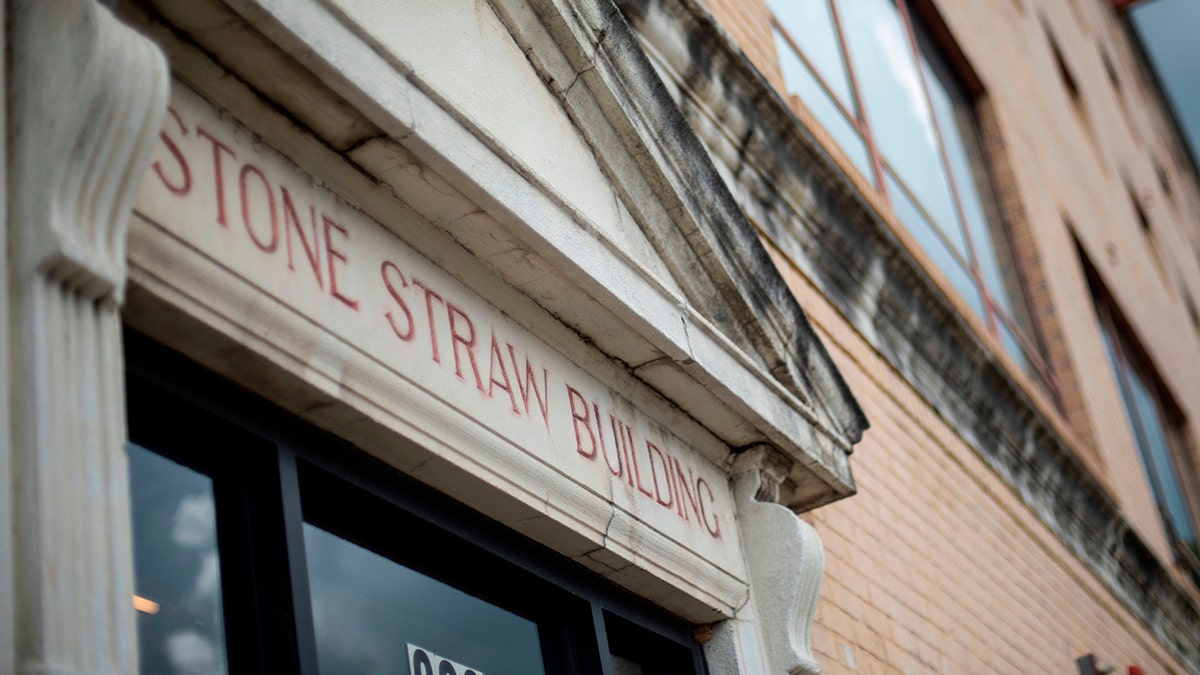
The historical Stone Straw Building. Paper drinking straws invented by Marvin C. Stone were produced industrially during a large part of the 20th century in this facility. Photographed on June 20, 2019, as Washington, D.C., enacted a ban on plastic straws. (ERIC BARADAT/AFP via Getty Images)
National Drinking Straw Day is celebrated by American strawophiles each Jan. 3, the date of Stone’s 1888 paper-straw patent.
CLICK HERE TO SIGN UP FOR OUR LIFESTYLE NEWSLETTER
His factory is a well-known D.C. landmark today. Stone himself became a historic international cause celebre in 2019, when the city instituted a ban on plastic straw.
"In the last century, millions of straws were produced in the Stone Straw Building, a stolid-looking structure of yellowing brick in a residential neighborhood," Agence France-Presse wrote in a worldwide report in June 2019.
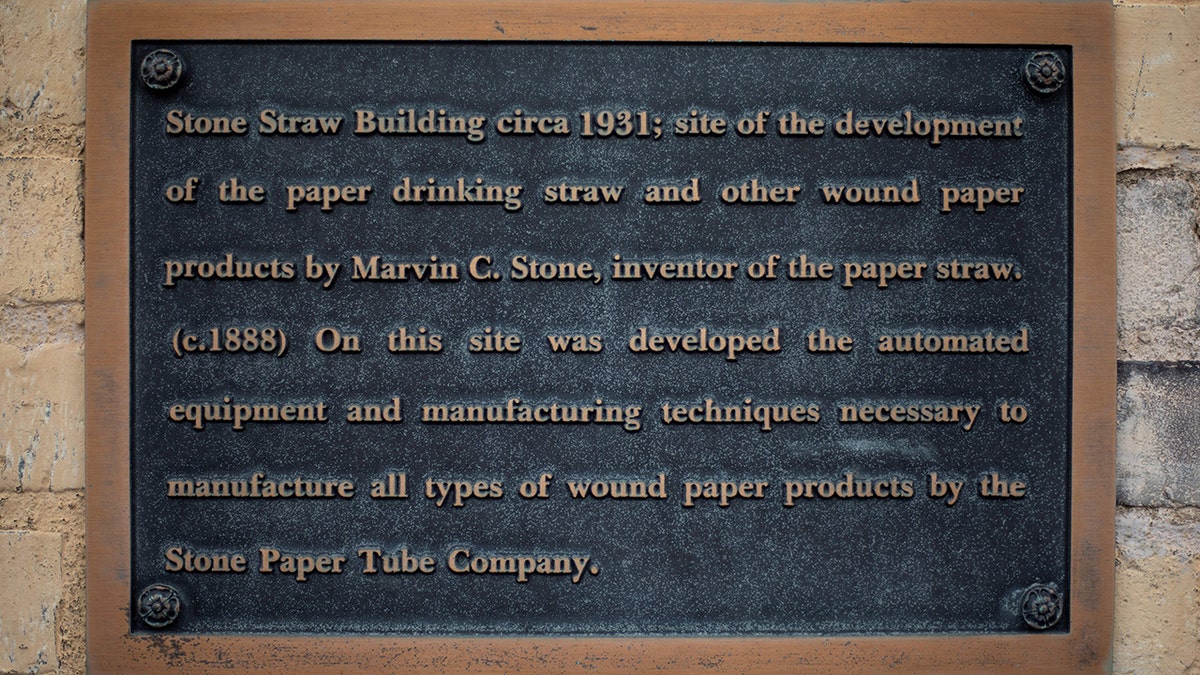
A plaque is seen at the historical Stone Straw Building in Washington, D.C., where the paper drinking straws invented by Marvin C. Stone were produced industrially during a large part of the 20th century. Photo from June 20, 2019, as the city placed a ban on more modern plastic straws. (ERIC BARADAT/AFP via Getty Images))
"The building now houses the capital's transit police headquarters. The only visible sign of its historic character comes from a discreet commemorative plaque affixed to a wall above a garbage bin that honors the memory of Marvin C. Stone, ‘inventor of the paper straw.’"
Stone was remembered fondly in his day as one of the leading citizens of the nation's capital.
"He was a kind employer, taking great interest in the welfare of those in his service." — The Evening Star of Washington D.C.
"Mr. Stone was at the head of one of the largest manufacturing establishments in this city," The Evening Star reported the day after his death.
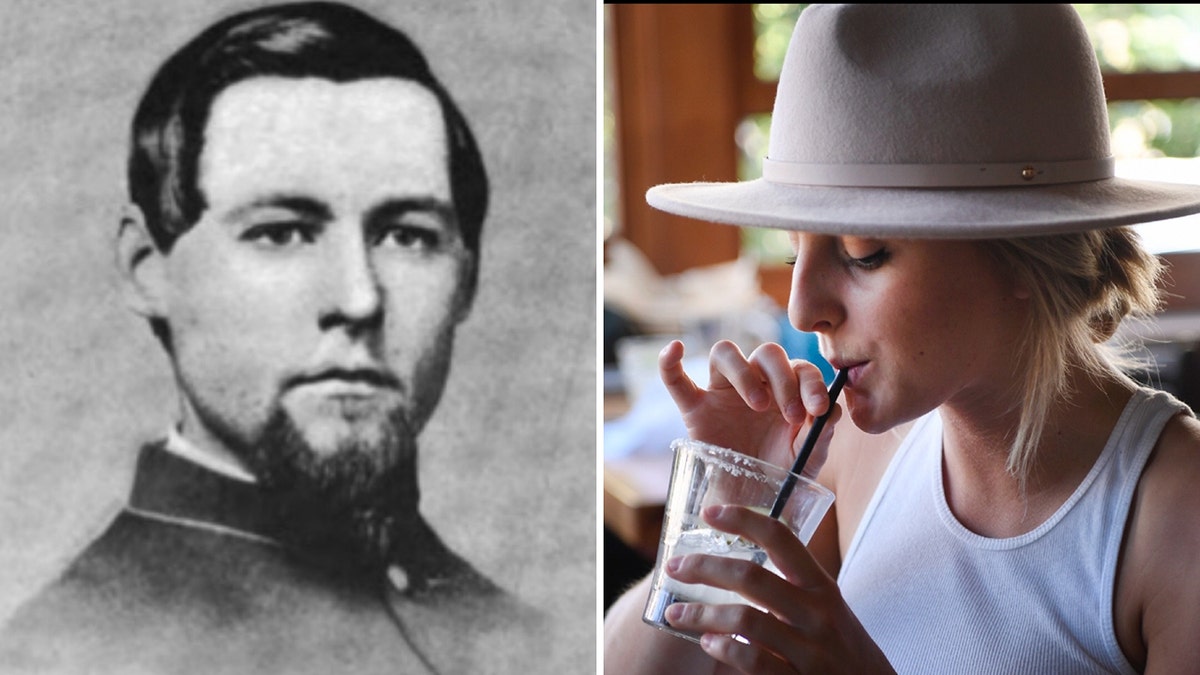
Marvin C. Stone, a Civil War veteran from Ohio, patented the paper drinking straw in 1888; on the right, wedding planner Monica Hamilton of Denver drinks with a paper straw in 2018. (Public Domain (left); Andy Cross/The Denver Post via Getty Images (right))
"He made this city his home and then began his carer of inventor and manufacturer, which he pursued with signal success. He was a kind employer, taking great interest in the welfare of those in his service. He provided for them a circulating library and looked after them in time of sickness and misfortune."
CLICK HERE TO GET THE FOX NEWS APP
He's remembered today for a rare remarkable achievement: Stone's simple paper straw changed global consumer culture once in the 19th century — and again in the 21st century.
To read more stories in this unique "Meet the American Who…" series from Fox News Digital, click here.


